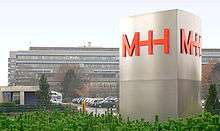Hannover Medical School
The Hannover Medical School (German: Medizinische Hochschule Hannover abbreviated MHH in German), founded in 1965, is a university medical centre in the city of Hanover, in Germany, part of a regional medical network.
Medizinische Hochschule Hannover | |
 | |
| Type | Public |
|---|---|
| Established | 1961 |
| President | Michael Manns |
Academic staff | 419 (2009) |
Administrative staff | 4,285 |
| Students | 2,668 (2009) |
| Location | , , |
| Campus | Urban |
| Website | www |
 | |
History
The origins of the Hannover Medical School (MHH) go back to 1961. In June of that year, the National Science Council (WR) recommended that seven new academies of medicine be founded in the Federal Republic of Germany in order to increase the number of students of medicine by 7,000. Within the month, the parliament of Lower Saxony decided to go forward with plans to establish a state medical university here.
A committee to found a medical academy of Hannover met for the first time in December 1961. By February of the following year, it had been decided that this academy would be located in the city of Hannover. On April 1, 1963, the government of Lower Saxony issued an order to establish the Medical Academy of Hannover, and this was to be the MHH.
In 1965, after less than four years of planning, the structure of the medical school had been decided on and construction plans were complete. On May 17, 1965, a celebration marking the founding of the MHH was held at the University of Veterinary Medicine Hannover. The founding rector of the MHH was the internist, Professor Rudolf Schoen of the University of Göttingen. He was succeeded by the first elected rector, Professor Fritz Hartmann, who played a decisive role in both the concept and physical form of the MHH. The MHH was realised as a university campus on grounds in Roderbruch. The close proximity of the clinics and institutes guarantees intense integration of patient care, research and teaching.
The first classes were held in the summer semester of 1965, in the Hannover Oststadt Hospital. The student-teacher ratio was ideal, with 12 teachers and 41 students, but this did not remain so for long. Within ten years, the number of students rose to about 1,000, and after only 20 years, to 3,000. With the addition of new departments, the original number of 12 professors increased to about 140. Only 12 years after the MHH was founded, 80 per cent of the planned departments and clinics had been realised.
As the MHH is both an academic and a clinical institution, the following watchword was chosen to express its commitment to its ideals and goals:[1]
Unitas in necessariis, Unity in what is necessary,
Libertas in dubiis, Liberty in case of doubt,
Caritas in omnibus, Charity in all things.
International
PhD students and scientists from all over the world are involved in a variety of research projects at the MHH and partner institutes. These activities are bundled in Hannover Biomedical Research School (HBRS).
References
- "History". MHH. Retrieved 2019-07-14.
External links
| Wikimedia Commons has media related to Hanover Medical School. |
- Official website of the Hannover Medical School (in English)
- Official website of the Hannover Medical School (in German)
See also
- Leibniz University Hannover—Official website (English version)
- Leibniz Alliance Hannover (LEAH)